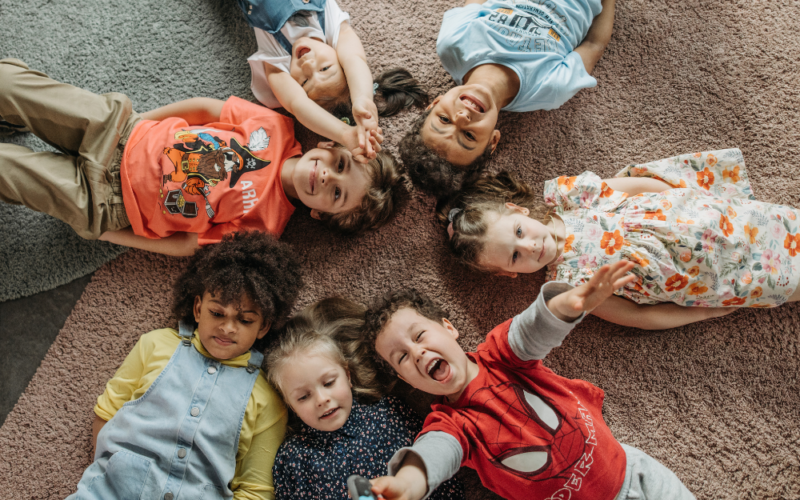“All children are born to grow, to develop, to live, to love, and to articulate their needs and feelings for their self-protection.”
Alice Miller
The process of growing up involves learning to relate and interact with other people, and to understand and control your own emotions. Social development is our interaction with others. It is the ability to form secure relationships. Emotional development is regulating and expressing emotions. It involves the way one feels about themselves, others and the world.
Babies start to grow familiar with the people around them right from birth, but the process of learning to communicate, share, and interact with others takes many years to develop. Acquiring the ability to control their emotions and behavior is also a long process. A wide body of research establishes that a robust social and emotional base in early childhood strongly influences children’s future positive attitudes and behaviors, academic performance, career path, and adult health outcomes.
Each day you help your child feel safe, secure, and loved, you are serving to lay the foundation for healthy social and emotional development of your child, which positions them to become happier individuals and succeed in school and in life.
Below are some of the typical developmental milestones for social-emotional skills in little children.
At various developmental stages up to the age of 3 years, your child will:
✔️ Cry to get needs met. They learn to cry in different ways to show hunger, pain, or being tired
✔️ Occasionally self-soothe by sucking on hands and fingers
✔️ Start to smile and look directly at you. Smile in response to caregiver’s smile
✔️ Play with toys by shaking them. Then start to prefer some toys over others. Then enjoy simple interactive games, like patty-cake and peekaboo. Thereafter, they start simple pretend play, like imitating what adults or other kids are doing
✔️ Become aware of which people are familiar and which are strangers. Then start to show stranger anxiety. May cry when familiar faces are not around. They start playing favorites with familiar people
✔️ Respond to other people’s emotions by crying, smiling, or laughing
✔️ Enjoy looking at themselves in the mirror
✔️ Gradually become more interactive
✔️ Have more temper tantrums and become more defiant as they try to communicate and be independent
✔️ Become interested in having other kids around, but are more likely to play alongside them (parallel play) than with them (cooperative play)
Between the ages of 3-4 years, your child will:
✔️ Share toys, take turns, help their friends, and cooperate with others
✔️ Initiate or join in play with other children and make up games
✔️ Be interested in pretend play, but may confuse real and “make believe”
✔️ Follow simple rules in games, but will always want to win
✔️ Begin dramatic play, acting out whole scenes such as travelling or pretending to be animals
✔️ Might be bossy and defiant
✔️ Show more independence
✔️ Show and verbalize a wider range of emotion (i.e. jealousy, excitement, fear, happiness, anger)
✔️ Become less egocentric
✔️ Be more even-tempered and cooperative with parents
✔️ May show attachment to one friend
✔️ Separate from parents or caregivers more easily
✔️ May still have tantrums because of changes in routine or not getting what they want
Wake-up call: If you notice some of the following things by the time your child is 4 years old, you need to find a way to address the issue.
❌ They are not able to initiate or join in play with other children
❌ They are not able to share at all with other children
❌ They want to be dependent on their caregivers for everything
❌ They are extremely inflexible about routines, and become extremely upset when things are changed
❌ They have extreme difficulty separating from their parents
❌ They are too passive or fearful, and do not want to try things other children their age are doing
❌ They have extreme fears that interfere with daily activities
Between the ages of 4-5 years, your child will:
✔️ Show some awareness of moral reasoning, such as “fairness”, and good or bad behavior
✔️ Develop friendships
✔️ Express more awareness of other people’s feelings
✔️ Enjoy imaginative play with other children, such as dress up or house
✔️ Get better at sharing and taking turns with other children
✔️ Enjoy playing games, but might change the rules as they go
✔️ Stick with a difficult task for longer period (controlling frustration or anger better)
✔️ Show an understanding of right and wrong
✔️ Listen while others are speaking
✔️ Play games with simple rules
✔️ Are more conversational and independent
✔️ Begin to understand what it means to feel embarrassed
Wake-up call: If you notice some of the following things by the time your child is already 5 years old, you need to find a way to address the issue.
❌ They are not interested in playing with other children
❌ They are not able to share or take turns with other children
❌ They want to be dependent on their caregivers for everything
❌ They are extremely inflexible about routines, and become extremely upset when things are changed
❌ They have extreme difficulty separating from their parents
❌ They are too passive or fearful, and do not want to try things other children their age are doing
❌ They have extreme fears that interfere with daily activities
When parents and caregivers develop positive relationships with children from birth through the early years, and appreciate them, children feel safe and secure, starting their journey of a healthy social and emotional development. This process affects how children come across the world, convey themselves, handle their emotions, and launch positive relationships with others.
Here we will offer some suggestions, organized by age, which will assist parents and early childhood caregivers to strengthen children’s social and emotional development. These suggestions are based on an extensive study of research focused on children’s social and emotional development. SUGGESTIONS FOR WORKING WITH INFANTS (Ages up to 2 years)
Create a predictable development environment. Right from the time of their birth, it is essential for children to feel safe and loved in order to develop a strong social and emotional foundation. Being aware of your child’s specific needs and where they are developmentally can help you regulate your care, environment, and daily activities. This may entail managing the expectations you have for your child’s behavior and learning, remaining sensitive to their unique needs, and if necessary, reaching out for additional help.
Get to know your child and respond to their lead. Pay attention to what your child feels curious about, how they are feeling, or what activities they enjoy. Taking cues from them will help you determine how to respond and to schedule your daily activities around their interests, which enhances their enthusiasm to engage with you and learn.
Infants can feel a range of emotions at a very early age. Listening carefully to what their behavior is saying will help you feel more confident about how to respond. Is the baby looking at you peacefully or smiling at you? They want to engage. Smile back, speak, sing, and interact with them. Is the baby cranky, moaning, uneasy, or looking away? They may be overwhelmed, so reduce noise and action, talk softly, sway back and forth with them, wrap them in your arms, and cuddle.
Be an emotional role model. Right from the beginning, infants learn by watching their parents and caregivers. When you respond calmly to situations, express, and show kindness to others; you teach your child how to behave and what to expect from later relationships.
Talk, read, and sing to your child every day. Infants pick up by interacting with those around them. These simple interactions make young children feel wanted and loved along with reinforcing their early development.
Offer wholehearted, receptive, and consistent care. Smile, giggle, and snuggle with infants often throughout the day. Look out for signals from them, what are they trying to tell you? Do they want attention, are they hungry, do they want to be held, or do they have a wet diaper? Learn to understand their cues, and meet their needs unfailingly and attentively.
Sustain set, reliable routines. Knowing what to expect during the day helps infants feel safe and secure. Try a consistent order of routines and activities each day, like regular feeding, sleeping times, or reading a book together.
Establish basic rules. Start establishing a few basic rules to help create the concepts. For example, “be safe,” “be kind,” and “take care of your things.” A young child will, of course, need a lot of practice and reminders to learn and follow these rules, but it is important for them to learn what these concepts actually mean. Then slowly you teach them what they need to do to follow these rules, for example, “be safe” can mean “do not go out alone” or “do not touch a knife.”
Play simple social games. Engage your infant in simple games like peekaboo and taking turns cooing back and forth. These games will teach turn taking and passing, which is an important element for future social development.
Imitate infants. Imitate their facial expressions and sounds, imitation sets the earliest foundation for relating with others.
Say what you think your child is feeling. This shows to the infant that you are paying attention to their needs and are there for them. Letting and encouraging children to express their feelings —positive as well as negative— can help their emotional development. Help your child to learn to calm themselves and praise them for doing so.

Provide them with playthings. Give your child age-appropriate toys and books that they can safely explore. Children enjoy exploring their environments. Create the space so they have safe access to developmentally suitable toys they can discover and play with autonomously.
Use power words. Start teaching short, powerful words and phrases that they can use, such as “Stop!” or “I don’t like that.” Make sure you use a steady tone of voice to model it. Using a physical gesture with the phrase, like the physical motion of putting a hand up for “Stop”, can help children retain the power words and provides them with something respectfully physical to do with their bodies in a conflict.
Establish the link between behavior and consequence. Help your child begin to learn that all behavior has a consequence. Guide their behavior to allow them to make links between their actions and what happens in response. It is important to relate the consequence to a child’s actions. To avoid power struggles, take care to use a neutral tone of voice and keep the consequence directly related to the action.
Demonstrate while you tell. When talking with your child about what they should do, use gestures and other visual clues to show them. Focus on the positive—the “do” rather than the “don’t.” For example, you could touch the car keys as you say, “When we have finished eating, then we can go outside for a drive.”
SUGGESTIONS FOR WORKING WITH TODDLERS (Ages 2-3.5 years)
Most of the suggestions mentioned above for infants are great for toddlers too. Below are more suggestions to address the developmental needs of toddlers.

Create a predictable development environment. A friendly and ingenious physical and emotional environment helps children feel safe and inspires learning, play, and exploration. Foster a positive relationship between yourself and your toddler. Talk to them often by making eye contact and saying their name. Throughout the day make time for one-on-one interaction with them, even if it is a quick hug, smile, or positive word. Your positive words and actions can be important in making a toddler feel safe and secure.
Listen actively. The most potent child development tool you have as parents –and as teachers- is active, empathetic listening. A young child going through strong emotions requires our attention and our empathy. This is how you can do it. Detect when your child is feeling strong emotions, such as irritation, anger, exhilaration, sadness, and joy. Move close to the child, bringing your body to their level. Establish eye contact and offer a gentle touch to help the child register that you are listening. Repeat back what the child is telling you through words and gestures in language that they can understand. Most importantly, reflect the same tone that they are expressing. Your tone, actions, and facial expressions allow a child with limited language ability to tell that you understand what they are feeling. You may feel a little uneasy the first time you do it, but as soon as it clicks for you, you will not care what you look or sound like because your child is hearing you and knows that you genuinely understand what they are feeling. Once you get used to it, this approach will be one of the most powerful tools in your repertoire.
Make available opportunities for playful group activities. Create opportunities for your child to be together with other children of similar ages. Place age-appropriate toys on the floor and allow children to play and explore together. Even if children play independently side-by-side, they still learn from their peers and develop social skills.
Offer your child choices. Create opportunities throughout the day for your child to choose activities, toys, or snacks. If your child does not yet have the words to express their choices, provide them with other communication alternatives such as pointing to items or pictures and even signing. Giving your child choices makes them feel heard, engaged, and in control.
Show your child how to share and take turns. Toddlers are starting to learn how to share and take turns, which is tough to do and takes time and practice. Make it easy for your child by teaching them through daily routines. For example, when your child is with other children, hand out two different snacks to each child and let them choose one snack to keep and one to share.
Encourage companionships. Toddlers normally play next to, instead of with, peers. You can utilize this important parallel play to give children the chance to exercise sharing, taking turns, resolving conflicts, and to come across the joy of friendship.
Foster positive behaviors and employ positive behavioral correction. To help your child develop positive behaviors, offer a lot of encouragement, and set standards in gentle ways. Stay cognizant of your child’s individual developmental markers and adjust your expectations of their behaviors accordingly. For example, do not expect a two-year-old to sit still, they have so much to discover and love to move around and explore. When you want them to sit for a while, try to keep their hands and minds engaged by reading a fun book or playing a game.
Focus on your child’s positive behavior and stay composed, using plenty of positive feedback and calm reminders as they learn new skills. Focus on what they can and should do rather than using words like “don’t.” For example, say, “Let’s use gentle hands,” instead of saying “Don’t hit.”
To help your child label their own feelings, you can use pictures of different emotions and label them for your child. You can also help your toddler put their emotional state into words and discuss why they feel a certain way. For example, “I sense you are feeling upset. Let’s talk to your friend about taking turns.”
Offer comfort and reassurance by letting your child know that it is okay to have strong feelings, like anger or disappointment, and that you are there to help them manage those emotions.
Teach your child ways to manage emotions. Each child is different — one child may want a hug, while another may need time with their comfort item (blanket or stuffed animal), and a third can use deep breaths to cool down. See what works for your child.
Reinforce new skills. Toddlers are just starting to follow directions and rules. Provide your child with abundant opportunities to practice new skills. Praise your child when they are learning a skill, especially when you know it is a behavior they have been working on, like taking turns or appropriately transitioning to a new activity.
Talk about emotions.When you identify and discuss emotions with your child, it helps them understand their own and others’ feelings. Find opportunities to identify and describe emotions. Reading stories affords a nice opportunity to discuss the connection between behavior and emotion. For example, “The rabbit is running so fast! He seems scared.”
Be a role model.Be a role model of positive behaviors for your child. When you show your child patience, gentleness, and care for others through your everyday interactions, you are helping them learn to treat others the same way.
Talk about your own feelings and emotions to model for your child how to use words or other strategies to communicate about emotions. You may say, “It’s hard for me to wait for my turn for the truck. I’m going to play with blocks while I wait.”
SUGGESTIONS FOR WORKING WITH PRESCHOOLERS (Ages 3.5-5 years)
Further to the suggestions offered for toddlers, here are some additional suggestions for the developmental needs of preschoolers.

Create a predictable development environment.Just as with younger children, a friendly and predictable setting helps preschoolers feel safe and boosts learning, play, and exploration. Preschoolers are willing partners to build their own little community at home or in classroom. You can play an important role in inculcating a sense of community in your child.
Be responsive to your child’s needs.Preschoolers may be more independent than toddlers, but they still need a great deal of warm and responsive care. Your role is to make them feel confident that you will fulfill their needs and will be there for them to solve problems and manage frustrations.
Give effective praise.Expressive feedback relevant to the task at hand in the form of encouraging words is an influential tactic for nurturing children’s social and emotional development. To make praise effective, describe what you see – without generalizing, appraising, or making comparisons. For example your child finishes a drawing and you notice their picture and their smile. You say, “I see a clear blue sky, a bright yellow sun, and thick green grass around the big brown tree. I can see this picture makes you happy, doesn’t it?” This praise is effective because you are providing detailed, positive comments instantaneously after appropriate behavior transpires.
Inform them of the plans in advance.Transitioning from one activity to the other is the time that can elicit inappropriate or challenging behavior in many preschoolers. Providing children with a “notice” before moving from one activity to another is especially important when they are transitioning away from doing something fun. For example, “In ten minutes we are going to tidy up your toys and move to the naptime.” Some children may need further reminders, like a one minute prompt or a physical reminder, like a gentle rub on their back.
Use daily activities to help them develop social skills.The preschool years are replete with possibilities to develop positive social skills — preschoolers engage in pretend play, start to explore cooperative play, and develop initial friendships. You can use a number of everyday activities, like snack time, outdoor play, and center time, to help children practice taking turns, playing together, and engaging in conversations. Some preschoolers will effortlessly engage with peers while others need help and support from other peers and adults. Try to reassure children to communicate in several ways they are comfortable with, like using their language skills, body movements, gestures, and signs. Incorporate activities that are designed so that children have to work together in small groups to complete a task.
Use books to teach social skills. Reading and discussing children’s books is a brilliant method to involve children to identify the characters’ emotions and relate the characters’ experiences to their own. Select books that include themes about making friends, taking turns, and cooperating. In the midst of a book, pause to ask your child what they might do in a similar social situation and ponder together on what happens in the story. Allow and encourage your child to express their feelings. Preschoolers have the capability to label and discuss their emotions — they just need to feel safe and welcoming to do so.
Assist your child in describing their feelings. Help them find words to describe how they feel. For example, “I can tell you are feeling angry and disappointed. Would you like to tell me why you feel this way?” You can also model appropriate vocabulary by describing your own feelings (e.g. “I was worried where I left my card, but am relieved because it was in my bag.”) Listen attentively when your preschooler shares their thoughts and feelings, help them know that their views, feelings, efforts, and accomplishments matter.
Acknowledge your child’s difficult emotions and help them to respond to them. Let your preschooler know that it is ok to have strong feelings like anger or disappointment and that you are there to help them deal with those feelings in a positive way.
Teach your child to consider how others feel. When reading a story, ask your child to visualize the characters of the story and guess how they might be feeling and why.
Convey behavior expectations.Engage your child in developing expectations about their behavior. Explain to your child what is and is not acceptable behavior and why. Use simple language (e.g., “Wear socks, please” and “Use gentle hands”) to set expectations and give reminders. Provide your preschooler with sufficient opportunities to practice these expectations and give them feedback about their behavior.
Model the behavior you expect from your child, they learn more by watching you then listening to you. Demonstrate suitable warm and respectful behavior throughout the day and at specific moments when a gentle reminder is needed. Move closer to the child, when needed, as a nonverbal cue to rethink behaviors. Use nonverbal gestures and contact (e.g., nodding the head, giving thumbs-up signs, and touching children gently on the shoulder) to convey feedback. Place your hand gently on your child’s hand to redirect attention and behavior
When your child behaves appropriately and kindly, offer special attention, hugs, or specific words of praise such as “It made me really happy when you helped your sister clean up today” or “I notice how properly you are eating your food. Great job.”
Engage your child in resolving their difficult behaviors. Stay calm when a child is not. Remain close to them to make sure they do not hurt themselves or others. Teach and practice calming strategies and appropriate responses to children when children are not upset. Offer them lots of positive encouragement. Some calm down strategies that can be taught to preschoolers are:
⭕ In a quiet place, away from provocation, sit beside your child and together breathe slowly and deeply. Show them how to rest their hand on their stomach to watch and count their breaths.
⭕ Encourage your child to draw a picture of what happened – before, during, and after the incident. Ask them to describe the picture and narrate what they were thinking and feeling at each stage.
⭕ If your child is angry, give them a pillow or another soft, safe object that they can use to express themselves physically. Ask them to narrate what they are thinking and feeling in this process. Providing your child with an opportunity to rehearse and go over particularly stimulating interactions can be a potent learning tool. Help them practice appropriate responses to usual preschool scenarios and offer lots of positive encouragement.







